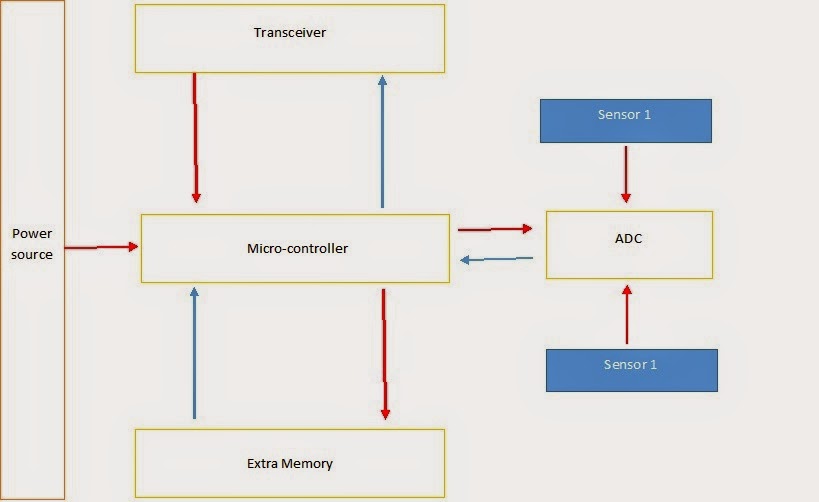Wireless Sensor Network
Overview -
Sensor ?
A sensor is a converter that measures a physical quantity and converts it into a signal which can be read by an observer or by an instrument. Processing such a signal reveals some properties about objects located and/or event happening in the vicinity of the sensor. A large number of these disposable sensors can be networked in many applications that require unattended operations.
Sensor node ?
A sensor node, also known as sensor pod or a mote, is a component of a wireless sensor network. Each node in the network is responsible for collecting data about the environment around it and sending that data to processors in the network. A mote is node but a node is not always a mote.
Fig 1: The typical architecture of the sensor node.
Components - The main components of a sensor node are a micro-controller, transceiver, external memory, power source and one or more sensors.
- Controller - The controller performs tasks, processes data and controls the functionality of other components in the sensor node. While the most common controller is a micro-controller, other alternatives that can be used as a controller are- 1. a general purpose desktop micro-processor, 2. digital signal processors, 3. FPGAs and ASICs. A micro-controller is used in sensor nodes because of its low cost, flexibility to connect to other devices, easy of programming, and low power consumption."A micro-processor has higher power consumption than a micro-controller, therefore not considered for sensor nodes"
- Transceiver - The functionality of both transmitter and receiver are combined into a single device known as a transceiver. Sensor nodes often make of ISM band, which gives free radio, spectrum allocation and global availability. Radio frequency-based communication is the most relevant that fits most of the WSN application.
- External memory - Memory requirement are depend on applications used.
- Power source - Power is stored either in batteries or capacitors. Batteries, both rechargeable and non-rechargeable, are the main source of power supply for sensor nodes. Current sensors are able to renew their energy from solar sources.
- Sensors - Sensors measures physical data of the parameter to be monitored. Sensors are hardware devices that produce a measurable response to a change in a physical condition like temperature or pressure. A sensor node should be small in size, consume extremely low energy, operate in high volumetric densities, be autonomous and operate unattended, and be adaptive to the environment. As wireless sensor nodes are typically very small electronic devices, they can be equipped with a limited power source of less than 0.5 - 2 ampere-hour and 1.2 - 3.7 volts.
Wireless Sensor Network (WSN) ?
A wireless sensor network (WSN) is a wireless network consisting of spatially distributed autonomous devices using sensors to monitor physical or environmental conditions. The importance of sensor networks is highlighted by the number of recent functioning initiatives, including the DARPA SENSIT program, military program, and NSF program announcement. Today such networks are used in many industrial and consumer applications, such as individual process monitoring and control, machine health monitoring etc.
The concept of wireless sensor network is based on a simple question:
Sensing + CPU + Radio = Thousands of Potential applications
The emerging field of wireless sensor networks combines sensing, computation, and communication into a single tiny device. Through advanced mesh network protocols, these devices from a sea of connectivity that extends the reach of cyberspace out into the physical world.
Fig 2: DOT - Wireless sensor network device
designed to the approximate size of a quarter.
Sensor Network Architecture -
Fig 3: The typical
Architecture diagram of Wireless Sensor Network
Application - Engineering have created WSN applications for areas including health care, utilities, remote monitoring etc.
- Area monitoring
- Health care monitoring
- Air pollution monitoring
- Forest fire detection
- Landslide detection
- Water quality monitoring
- Natural disaster prevention
- Machine health monitoring
- Data logging
- Water/Waste water monitoring
- Structural health monitoring
- Asset tracking
Learn more at http://en.wikipedia.org/wiki/Wireless_sensor_network
Characterstics - The main characteristics of a WSN includes:
- Power consumption constraints for nodes using batteries or energy harvesting.
- Ability to cope with node failure.
- Mobility of nodes.
- Heterogeneity of nodes.
- Scalability to large scale of development.
- Ability to withstand harsh environmental conditions.
- Ease of use.
- Cross-layer design.
Issues and Challenges -
- Sensor nodes are randomly deployed and hence do not fit into any regular topology. Once deployed, they usually do not require any human intervention. Hence, the setup and maintenance of the network should be entirely autonomous.
- Sensor networks are infrastructure-less. Therefore, all routing and maintenance algorithms need to be distributed.
- Energy problem
- Hardware and software should be designed to conserve power
- Sensor nodes should be able to synchronize with each other in a completely distributed manner, so that TDMA schedules can be imposed.
- A sensor network should also be capable of adapting to changing connectivity due to the failure of nodes, or new nodes powering up. The routing protocols should be able to dynamically include or avoid sensor nodes in their paths.
- Real-time communication over sensor networks must be supported through provision of guarantees on maximum delay, minimum bandwidth, or other QoS parameters.
- Provision must be made for secure communication over sensor network, especially for military applications which carry sensitive data.
Reference -
****ATCAPH.com****




well done
ReplyDelete